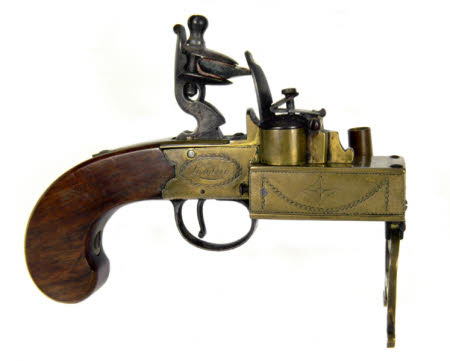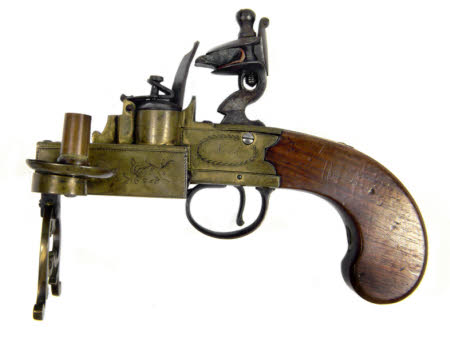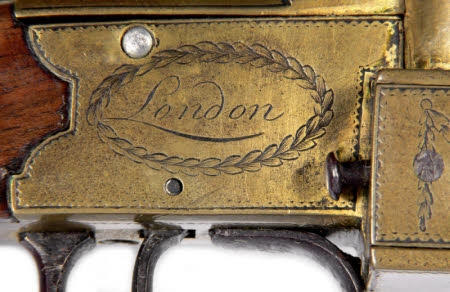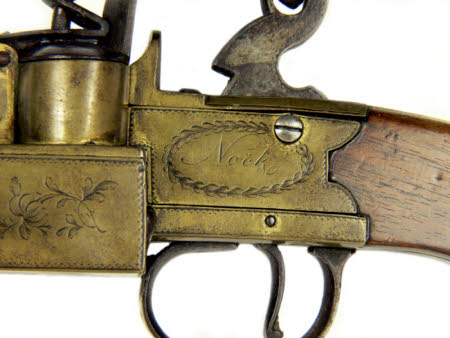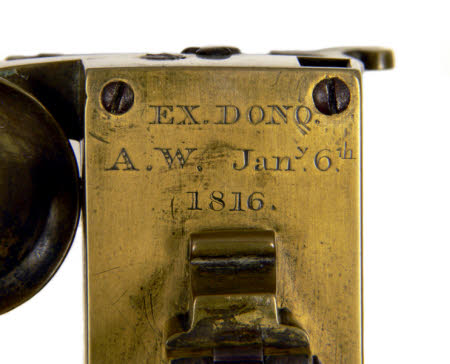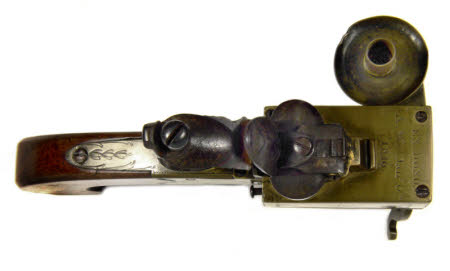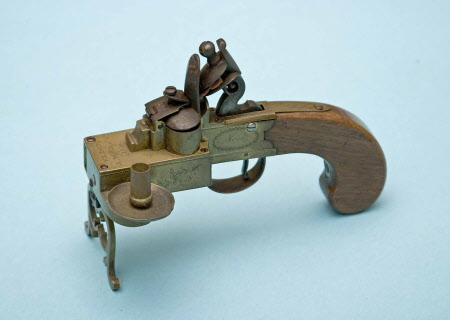Lighter
Henry Nock (fl.c1770 - 1804)
Category
Arms and armour
Date
1816
Materials
iron, brass, wood
Measurements
130 mm (H)172 mm (Length)85 mm (D)
Place of origin
London
Order this imageCollection
Felbrigg, Norfolk
NT 1400345
Caption
This may look like an oddly shaped pistol, but it is actually a cleverly concealed lighter. Before the invention of reliable matches in Europe in the 19th century, households relied on flint, steel and tinder (dry material such as wood shavings or grass) to create a flame and keep fires burning in the hearth. Lighting a fire could be time-consuming and by the 18th century flintlock tinder lighters, or ‘strike-a-lights’, were popular in wealthy households. This one at Felbrigg Hall was made by the Nocks, a famous family of London gunsmiths, and is inscribed ‘A W Jan. 6th 1816’ – although the owner of the initials remains a mystery. Tinder lighters were innovative, practical and portable. When the trigger is pulled, the flintlock mechanism strikes the flint against the steel ‘frizzen’ to generate sparks. Unlike a flintlock pistol, where the sparks fall into a pan of gunpowder, igniting the main charge of powder inside the barrel to fire a projectile, in the case of the lighter the sparks fall into a pan of dry tinder. This flame lights a candle, fitted in the attached candleholder. Electricity was not installed at Felbrigg Hall until 1954 because the owner, Robert Wyndham Ketton-Cremer (1906–69), liked the restful light of oil lamps and candles.
Summary
Flintlock tinder lighter by Nock of London, dated 1816.
Full description
Flintlock tinder lighter signed Nock, London, dated 1816. Celebrated London gunmaker Henry Nock worked from c1770 until 1804. This tinderlighter is characteristic of his work and the inscription may have been added after Nock's death in 1804. Alternatively it may have been the work of nephew Samuel Nock of London (active 1800-1851). Engraved brass box-lock action with large integral pan for tinder, side mounted candleholder (replaced) and forward compartment tinderbox with spring activated side cover. Side panels of the frame and tinderbox engraved with swags and laurel leaves. Signed alternatively on each side of the frame NOCK, LONDON and inscribed on the top of the tinderbox compartment, Ex.Dono. A.W. Jan. 6th 1816. Pierced 2 legged stand, the feet cut with scrolls. Iron flintlock action with ring-necked cock; iron bow-shaped trigger guard and curved trigger. Plain walnut slab-sided grip. Overall length: 18cm.
Provenance
Part of the Windham Collection. The hall and contents were bequeathed to the National Trust in 1969 by Robert Wyndham Ketton-Cremer (1906-1969)
Marks and inscriptions
Frame sides: Nock, London
Makers and roles
Henry Nock (fl.c1770 - 1804), gunsmith
References
Blackmore, 1986: Howard Blackmore: A Dictionary of London Gunmakers 1350-1850
